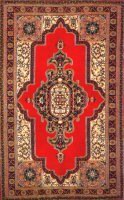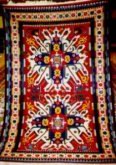|
 Hereke : They are easily noted once one learns to "read" or recognize
the patterns or designs and colours associated with the geographical area
in which produced. the finest contemporary and highest quality of silk
and wool carpets currently made in Turkey are produced in town near Istanbul,
called Hereke. The Hereke carpets are either woven in pure silk or cotton
and wool. The pure silk carpet uses silk from Bursa. In wool and cotton
carpets the warps and welfts are cotton and the best quality of wool is
used d-for knoots in the pile. Hereke : They are easily noted once one learns to "read" or recognize
the patterns or designs and colours associated with the geographical area
in which produced. the finest contemporary and highest quality of silk
and wool carpets currently made in Turkey are produced in town near Istanbul,
called Hereke. The Hereke carpets are either woven in pure silk or cotton
and wool. The pure silk carpet uses silk from Bursa. In wool and cotton
carpets the warps and welfts are cotton and the best quality of wool is
used d-for knoots in the pile.
 The silk Hereke carpets has from 1.0 to 1.2 million knots
per square meter. The knot density in the highest quality wool carpets
is any where between 360,000 to 400,000 knots per square meter. In second
quality wool carpets the knots are around 250,000 to 300,000 per square
meter. The dominant colours in Hereke carpets are dark blue, cream and
cinnamon and occasionally yellow and green are used. The treditional floral
designs are common and each design has its own name, such as : Seljuk
Star, Seven Mountain Flowers, Ploneise, 101 Flowers, and Tulip. The flowers
in the design and the hormany of colours add warth to a home. The silk Hereke carpets has from 1.0 to 1.2 million knots
per square meter. The knot density in the highest quality wool carpets
is any where between 360,000 to 400,000 knots per square meter. In second
quality wool carpets the knots are around 250,000 to 300,000 per square
meter. The dominant colours in Hereke carpets are dark blue, cream and
cinnamon and occasionally yellow and green are used. The treditional floral
designs are common and each design has its own name, such as : Seljuk
Star, Seven Mountain Flowers, Ploneise, 101 Flowers, and Tulip. The flowers
in the design and the hormany of colours add warth to a home.
Kayseri
The town of Kayseri, situated in central Turkey, has been famous as a
carpet making center for centuries. Carpets and Kilims of Kayseri are
of various types. Silk carpets, Wool on cotton and natural wool (no dyes),
and Bunyan carpets are the major categories produced. Kayseri carpets
are woven both at the workshops and in the homes. Weavers usually buy
yarn from shops and after finishing their carpet would sell it to the
same shop in order to buy more yarn. This carpets are considered the masterpieces
of Kayseri and as such are sought out by dealers to sell to the foreign
trade. Sometimes Kayseri carpets are woven entirelly in silk and will
have 600,000 to 700,000 knots per square meter.

Kayseri Wool on Cotton carpets are offen in floral designs of a typical
Oriental carpet. The yarn is cotton and wool dyed with wegetible dyes,
and about 120,000 to 150,000 knots per square meter.The Kayseri Bunyan
carpets are made in different sizes; from pillow sizes of 62 by 100 cm.
to the large 16 square meters carpet. Kayseri natural wool carpets have
all the properties of Bunyan carpets execpt there are not as many colours
used as in the Kayseri Bunyan carpets. Colours of white, cream, light
and dark brown and sometimes black are used in this types of carpets with
the same number knots as in the Kayseri Bunyan carpets.
 Ladik Ladik
Ladik is a town located north of Konya in the hearth of Anatolia. The
main sources of income in this area are animal husbandary, agrigalture
and carpet production. Konya and Ladik are the oldest carpet making centers
in Turkey. Even during the 15th. center the art of carpet weaving florished
in Konya becouse it was the capital of the Seljuk Empire and a very important
cominication and political center. There are many notible at works an
konya and perhaps the most famous in the Green Mosque. From Arabia, Iran
and other countries many artists came to Konya to practice their crafts.
The surviving carpets of this era offer ample evidence of the Turkish
character. During this same period carpet weaving skils pread from Konya
to other parts of Anatolia. The colours in Ladik carpets are very vivid
and vell matched. After Kula carpets, Ladik carpets, with their 250,000
knots per square meter, are considered just as fine.
Dosemealti-Antalya
These carpets are made by Yoruk's semi-nomadic tribes who leave near the
ocean on the warm plains during the winter months. The willages are arround
Antalya, on the Mediterranean cost, are the main producing centers of
this type of carpets are made with wool and dyes produced by the nomads
themselfs. The predominant colours are always bright red and dark blue,
with a smaller amount of white. Distinctive patterns in the borders are
the sheep's eye and knife tip and the "hands on hips" motif, an age old
symbol denoting female fertility which dates back to the time when the
tribes worshipped mader goddesses. The field are usually are taken up
by a large red double mihrab, edged in ram's horn motif. Often the shape
of the double mihrap is cut into by two triangles on either side. Ears
of grain representing fertility and carnetions are frequently seen. If
there is a tree of life it's generally made up of carnetions, "the flowers
of the people". Some times one can see a strange motif, a stylized representation
of the human figure which is used to guard against evil. The number of
knots in these carpets are equal to 160,000 knots per square meter.
 Kars Carpets Kars Carpets
Kars is located near the Russian border of Turkey, produces carpets designed
in the caucasian style. The main motif used is the large crucilform. The
quiet olive-green combin&d with~a dull red-brown and lighter beige
tones give the piece an enormous warmth. The eight stylized trees of life
in the corners are surrounded by a Caucasian calyx-and-leaf border and
the guard stripes are called 'running dogs." The extremely valuable hand-spun
mountain wool is used in the hand weaving and is especially prized by
acknowledged buyers. Natural dyed wool is used with the dominate cdours
navy blue, red and cream. There are 200.000 knots per square meter in
Kars carpet's and for this reason Kars carpets are so noted fine works
of art.
Kozak Carpets
Kozak carpets are woven by semi-nomadic shepherds who live in the highland
regions of the Caucasus mountains and their environment is reflected in
their products. The distinctive designs in Kozak Carpets can be easily
recognized. The warp and weft threads are wool with the weft threads always
in red or brown colours. The wool pile in these carpets is fairly deep
and the yarn used is always of excellent quality. The Kozak carpet has
approximately 50 to 100 Turkish knots per square inch. The motifs used
in these carpets are, formal, geometric, central medallion, repeated pattern
and "Eagle." True kozak carpets are mostly antique pieces and were produced
in the Caucasus Mountains. Currently a limited number of Kozak carpets
are produced and are much prized by dealers.
|